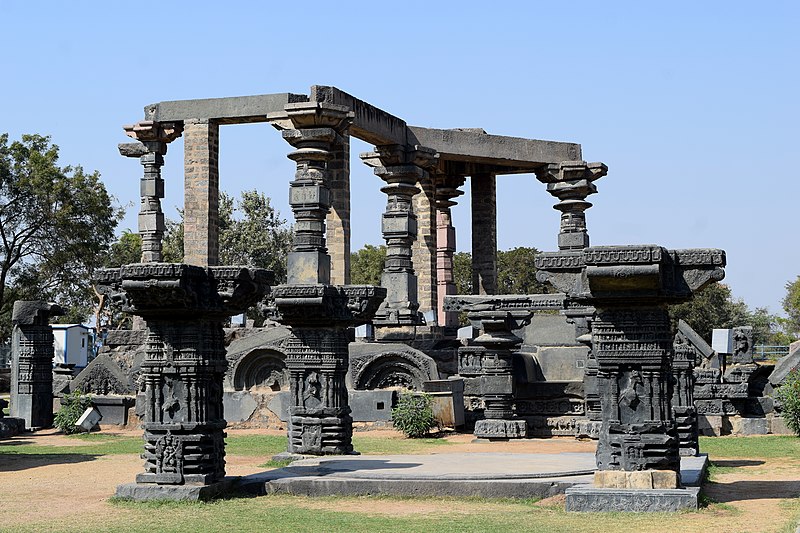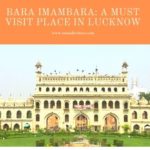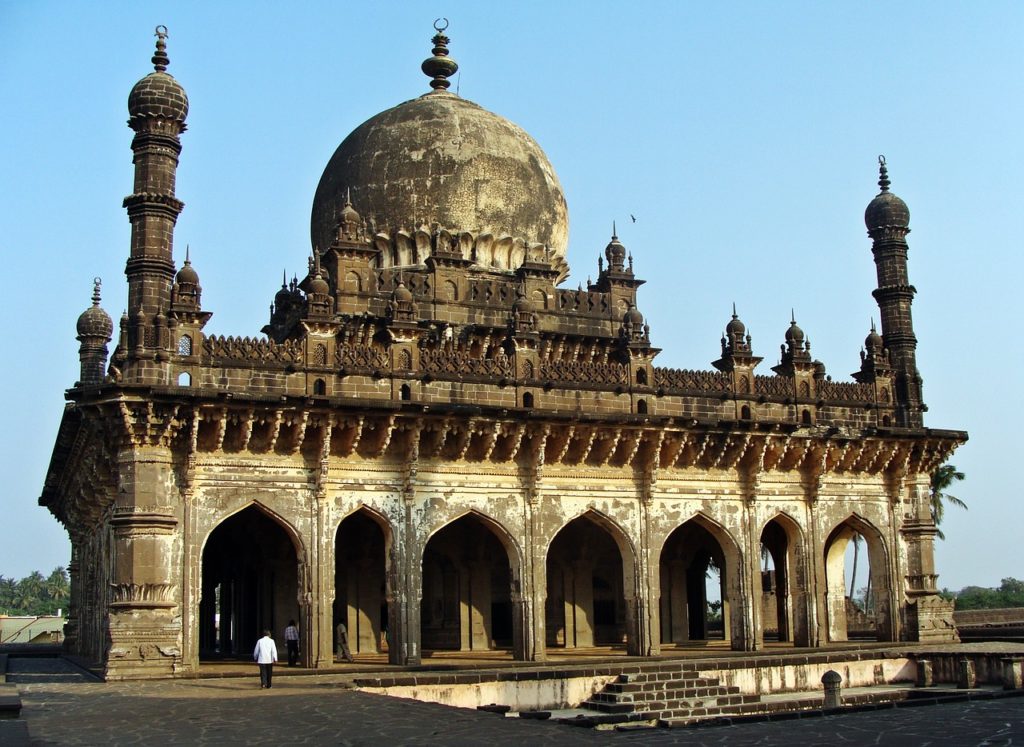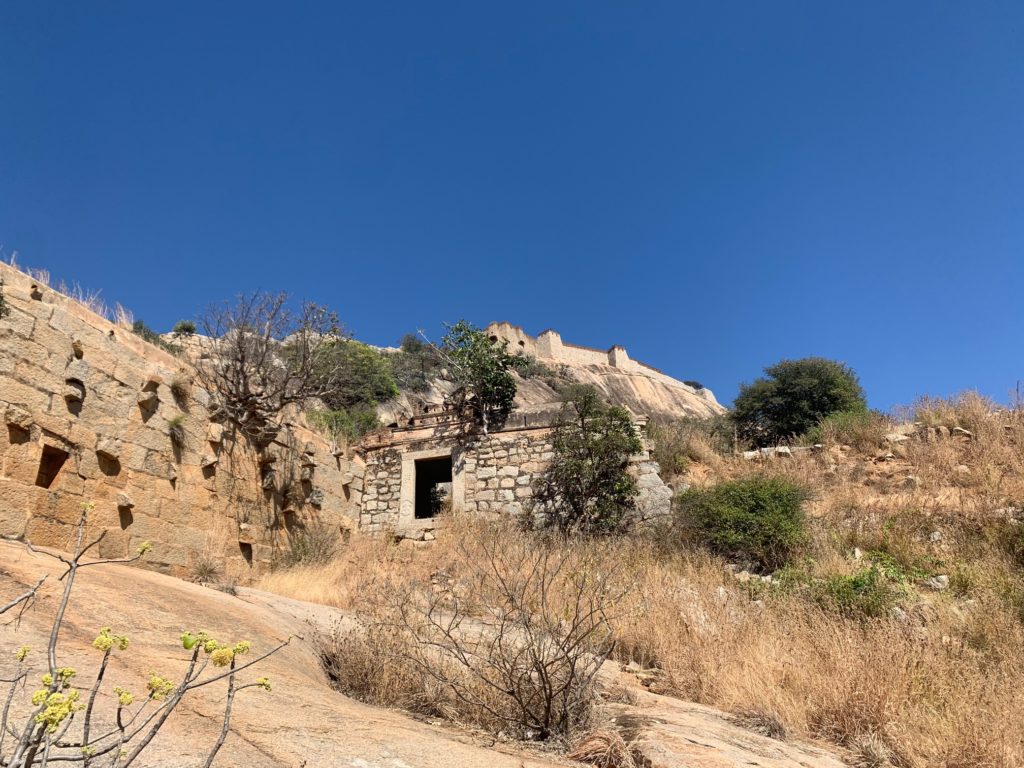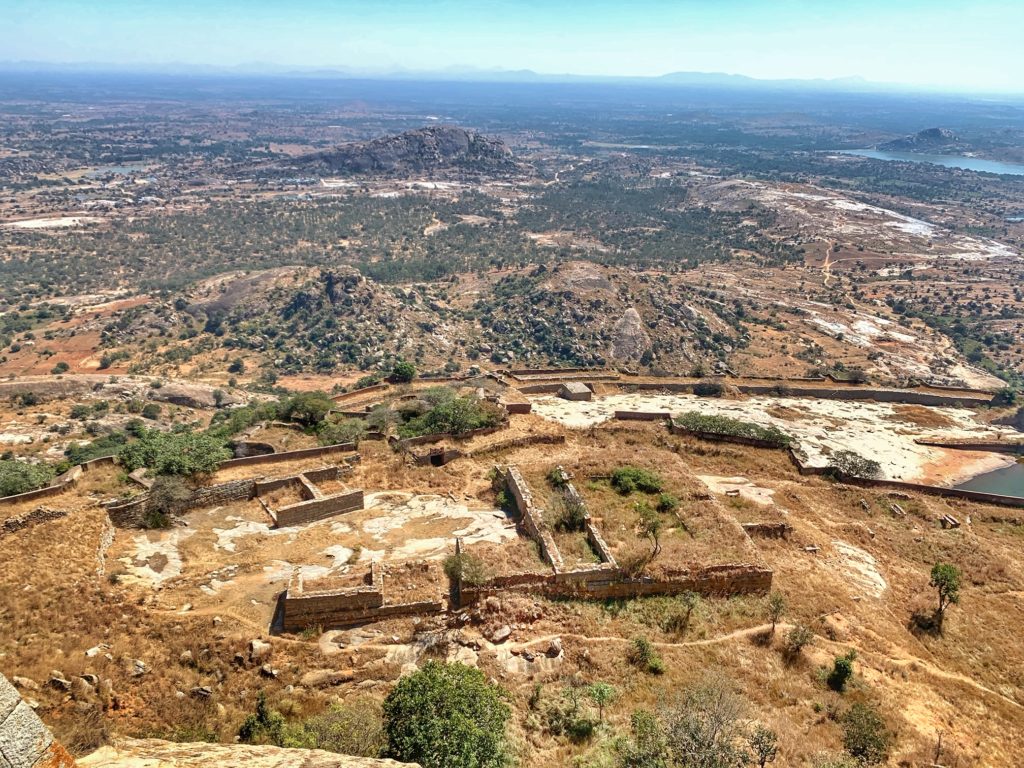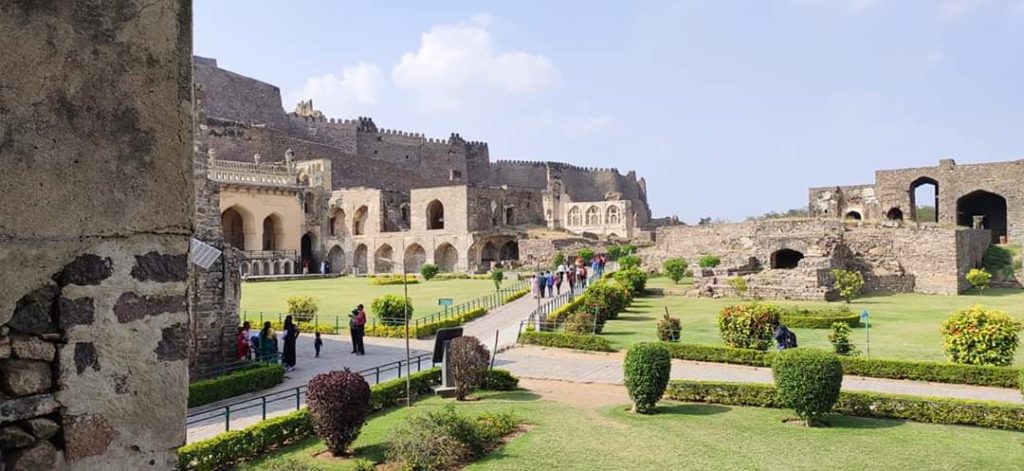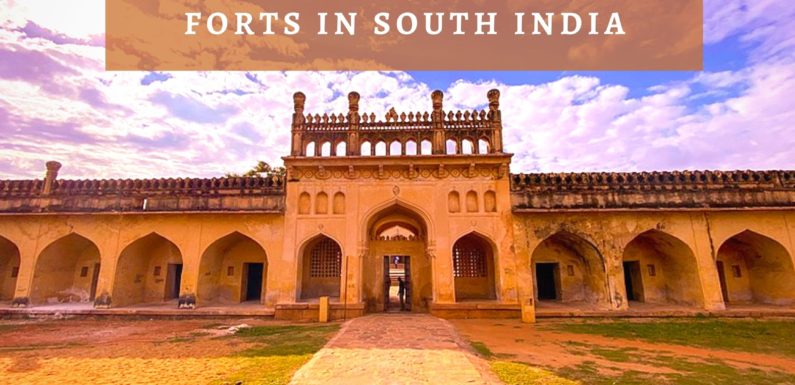
When you think of Forts in South India, the first thing that comes to your mind is the grandiose blend of traditional and modern architectural style. The forts in South India were mainly used as military bases and for trade purposes. These magnificent forts stands as an evidence of India’s historical past and reflect lifestyle, traditions and heritage of the bygone years.
Here is a list that I, along with some of my travel mates have compiled for you. The states covered in this post are:
- Andhra Pradesh
- Karnataka
- Kerala
- Tamil nadu
- Telangana
Forts in Andhra Pradesh
1. Chandragiri Fort
A fort fabricated with stone, brick, lime, mortar and much fortitude divulge a long legacy of the Vijayanagar empire of Chitoor district, Andhra Pradesh. Originally put together by the Yadavaraya dynasty in 1000 CE, Chandragiri was captured along with the fort in 1367 by the forces of Vijayanagar. When the war of Talikota broke in 1565 CE, Hampi (the first capital of Vijayanagar) was rubbed into ruins which today is quite an attraction amongst hippie travellers. Later, the capital was shifted to Chandragiri, a much fortified and shielded city and much later in 1646, the fort was annexed to the Golconda territory.
One can spin a yarn about the magnificence of the Vijayanagar empire and its rulers as it holds innumerous events to be mentioned and awestruck about. Same goes for its architecture, the carefully carved pillars incorporating Hindu-Islamic influence and the two grand gateways will lead you to the inner forts – Raja Mahal and Rani Mahal.
The Durbar Hall of Raja Mahal is this larger-than-life dreamlike space that will leave your jaws dropped for the time you’re there. Archaeological Survey of India (ASI) manages a museum in the Mahal exhibiting the olden sculptures and collectibles from the 14th century. If the account of this noble way of life intrigues you, pay it a visit to absorb the true essence of it. It falls only 16 kms away from Tirupati (the place of holy temples and men) railway station and only 30 kms away from the Tirupati Airport. Go go go!

2. Gandikota Fort
“God is in the details”
The quote by the famous architecture Mies van der Rohe falls so true for the Grand Canyon of India which is originally known as the Gandikota fort. Extraordinarily carved at every inch, this fort is gigantic and gorge-ous.
Gorge in Telugu translates to ‘Gandi’ and Kota means ‘fort’. This fascinating structure lies at the bank of the sonorous Penna river, 15kms away from Jammalamadagu in Kadapa district. Untouched and holding strong, Gandikota has withstood centuries. It was found in 1123 by Kapa Raja, second in command to Ahavamalla Someswara 1, the western Chaulakyan king of Kalyana.
Apart from the extensive history of its existence, what mesmerizes you the most about is the elaborate architecture. The first edifice that you see as soon as you enter is the ‘Charminar’ with much resemblance to the known one in Hyderabad. It’s very well maintained with four minarets on the top. Right opposite to the minar is Jamia Masjid. Arched gateways, intricately designed domes, mihrabs and minarets, every element of this Hindu-Islamic assemblage is worth giving a closer look. You will also come across ‘Kartuala Koneru’, an ancient water tank used to wash off weapons post the war.
GandiKota will lay out multiple marvels for you to sit and admire. Even the storeroom built in those days was well-mused over and could hold countless arms and provisions.
There are two temples in the premises – Ranganathy Swamy Temple and Madhvaraya Temple, both of them are crafted by proficient men of those days. Every pillar is intricately chiseled with the art of Indian mythology.
It is impossible to suffice the grandness of this structure in a few words. The craggy rocks of the Erramala hills eroded over centuries to form the Grand Canyon of India. The enormous boulders are composed of granite and immeasurable beauty. The gorge makes for a great defense wall from the west and north side. This utmost surreal place is a must-visit if you are in Andhra Pradesh.
The nearest railway station is 26 kms away – Muddanaru and the nearest airport is 77 kms away. There is a good frequency of buses from Jammalamadagu old bus stand. Hands down, this fort deserves to be in your travel destination list.

3. Gooty Fort
Located on a hill in the town of Gooty (previously known as Gowthampuri), Andhra Pradesh, the Gooty Fort is one of the centrally protected monuments of national importance in our country. The inscriptions its wall date back to the 7th century. Behind these inscriptions was hidden, an interesting fact that the fort was called ‘Bukkarya’ earlier which means ‘The King of Forts’.
The sheer height of the location of this granite rock structure surpasses your exceptions in human capabilities. This flamboyant Hindi-Islamic construction includes materials such as fine stone, mortar and limestone, ensuring sustainability. Inside the fortifying walls, several temples and mosques have been erected that serves as an example to the progressive engineering of the Chaulakya Period.
The Chaulkyas ruled between the 6th to 12th century post which the fort was besieged by the Vijayanagara Empire and the Qutb Shahi Dynasty consecutively. The Mughals also allegedly overthrew the Qutb Shahi Dynasty later when they captured their capital Golconda gaining possession of the fort. Around 1746 CE, the Marathas came into the picture. Their general Morari Rao captured this magnificent marvel and made it his permanent residence for about eight years. There’s also a polished limestone pavilion called Morari Rao’s seat on the edge of the cliff where the fort stands.
The history of this place is vibrant and endearing. It is endearing because the walls and the corridors of The Gooty Fort have protected and housed many dynasties along the way without discriminations. Each resident added a tassel to the beauty of the fort making it a grand spectacle to experience at least once in a lifetime.
You can reach here by road, either from Anantapur or Kurnool. The nearest airport is Bengaluru Airport about 237 km away and the nearest railway station is the Gooty Railway Station, 5 km away from this historically rich destination.
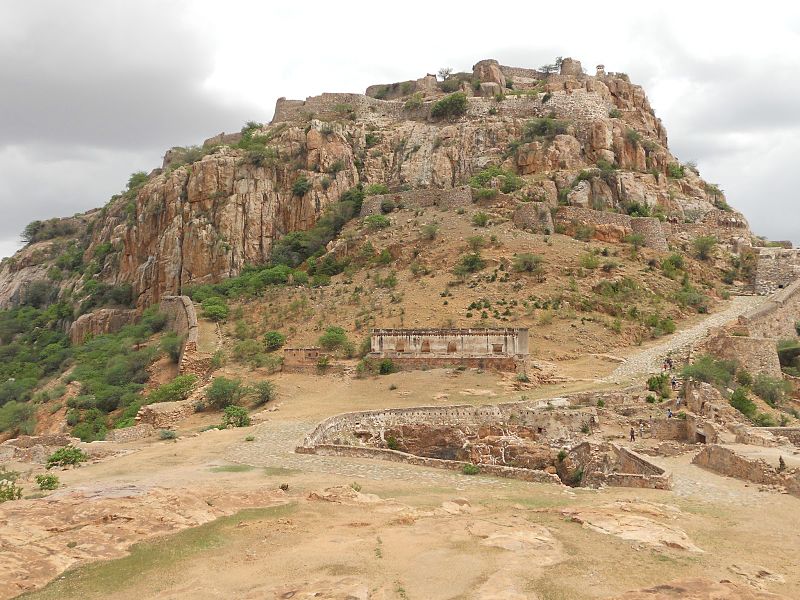
4. Udayagiri Fort
This absolutely rich in culture and heritage town of Udaygiri, Nellore in Andhra Pradesh is known as the ‘Nawabi Adda’, ruled by the chieftains of the Nawabs of Golconda and Arcot until 1839. The golden reign of the Gajapatis and Vijayanagar empire prevalent in the 14th and 15th centuries is reflected through the ruins of 365 temples across the town.
The delicate and graceful imprints of the royal period still remains on the walls and gates of the forts and other architectural marvels of this town.
Enveloped with profuse greenery from all sides and sonorous waterfalls, the Udaygiri Fort entices you to walk into its massive complex of 13 fortresses. Constructed by Langula Gajapati with robust fortifications, the fort could only be accessed through the jungle from the east and a path from the west initially and held utmost importance back in the days.
Local folklores that goes around the ‘Sanjiva Hill’ that you hike upon saying that you find the lifesaving herb ‘Sanjeevani’ here.(The first image that comes to any of our heads is that of Hanuman carrying an entire peak on his shoulders).
Udaygiri is a concoction of two cultures as you can notice the Persian inscriptions that credits Shaik Husain and Sultan Abdullah of Golcondaon the mosque that’s instilled on the hills – Chinna Masjid and Pedda Masjid. Other structures on the hill are the sacred and filled with splendor temples put together during the reign of Chola, Pallava and Vijayanagar dynasty like Ranganatha Temple, the Balakrishna Mandiram and the Paruveta Mandapam.
It’s a quite recent story that an underground tunnel has been excavated by the Department of Archaeology. The fort holds a festival every year on the 26th of the Rabi-UI-Aval month called as the Sandal Festival. Now, this reservoir of historic tales and unparalleled architecture is converted into a bio-diversity park by the Tamil Nadu forest department.
Udayagiri Fort which is located about 100 km From Nellore. Rooted atop a hill at the height of 3079 feet, you can only leave the imprints of your footstep till the fort as it leaves an indelible mark on your memory.
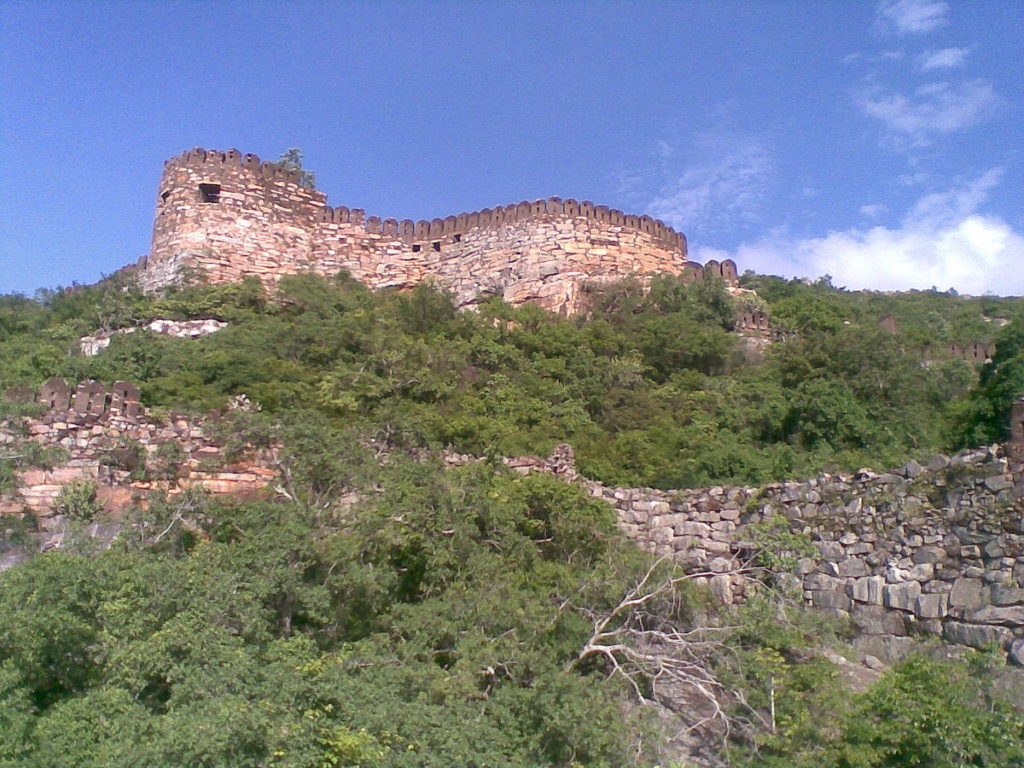
The forts in Andhra Pradesh were recommended by Akshita Parihar. Akshita documents i.e. photographs and writes about the folks in their natural element. A spiritual seeker and a nihilist at times left Bombay after working in the advertising industry as a copywriter for 4 years to dig in the culture of this country, the anthropology enthusiast also loves to illustrate, dance and hum Leonard Cohen and Johnny cash songs on the guitar.
Forts in Karnataka
5. Bangalore Fort
This fort was built by Kempe Gowda I, the founder of the city of Bangalore. The fort was initially made up of mud but later on Tipu Sultan’s father Hyder Ali built a stone fort to increase its strength. The fort complex houses a Ganpathy temple and a British plaque declaring the Siege of Bangalore.
A fort which was once depicted a glorious past was gradually dismantled by the government for construction purposes. Out of the original 26 bastions, only one survives today and the granite from the structure has been used to built other buildings in Bangalore.

6. Bidar Fort
The shifting of the capital city from Gulbarga to Bidar by Sultan Alla-Ud Din Bahman of Bahmanid Dynasty, one of the major medieval Indian kingdom, bought recognition to this hill top city. Made up of laterite stone on the fringes of the Bidar plateau, the fort has a quadrilateral shape.
There are 37 bastions fitted with canons and 7 gates to Bidar fort. In recent years, the fort was used as a backdrop for a famous Bollywood song from the movie Dirty Picture.
If you are visiting Karnataka, then make sure you have Bidar on your list. The fort complex also has a well equipped museum that tells the saga of the Bahamani Sultanate.
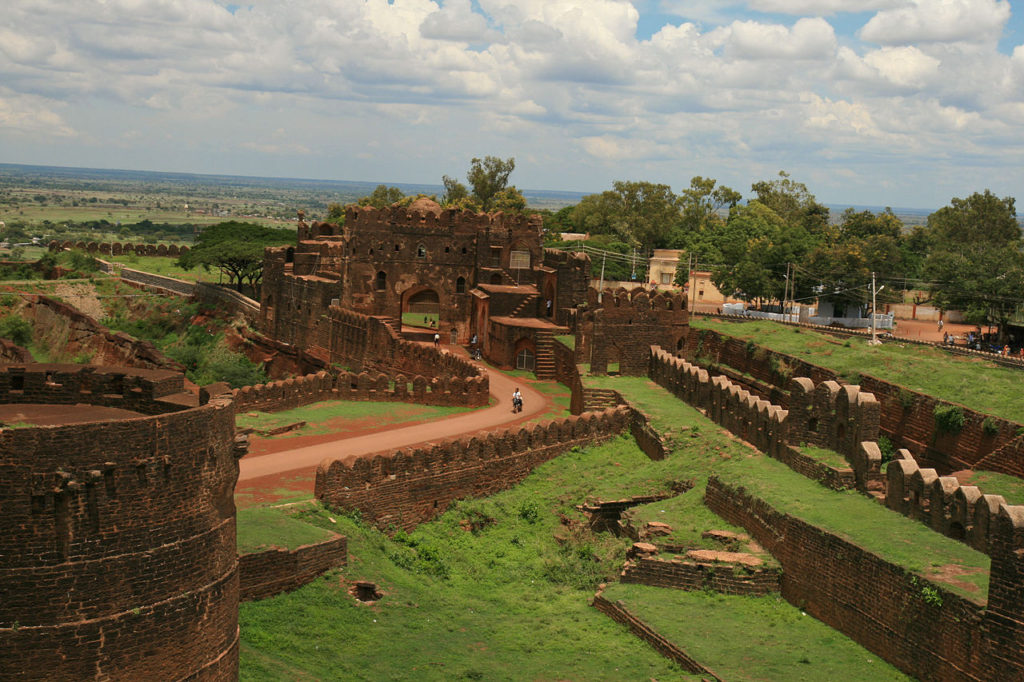
7. Bijapur Fort
Built by Adil Shahi dynasty, who ruled almost for 200 years in Bijapur, the Fort is a reminder of their might and grandeur. The motivation to become great led each King of Adil Shahi dynasty spending their resources to built marvellous structures of architecture and art. The area inside the fortified walls and around the city is home to many such works of wonder.
Bijapur is rightly referred to as ‘Agra of South India’, due to its monumental splendour and architecture. The fort complex houses a citadel, a mosque, tomb of Ali Rauza, a stepwell, many palaces and well groomed gardens.
8. Channarayana Durga Fort
Recommended by : Raksha Nagaraj
Raksha is an Indian girl living in Sydney. Her passion is travel and she has traveled to 40 countries. She documents her travel journeys on her blog Solopassport. Her main focus is solo traveling and hopes to encourage and motivate female travelers in stepping into solo traveling.
I was pleasantly surprised to find that there were so many forts around Bangalore, all within a vicinity of 100 kilometres. Of all the forts I visited, Channarayana Durga Fort was the one that stood out. Nestled in Tumkur district in Karnataka state, Channarayana Durga hill is a great weekend hiking getaway. The fort is on top of the hill and is said to have been built in the 17th century. The fort was initially constructed by a local king Chikappa Gowda. It then fell into the hands of the Marathas and subsequently to the Mysore Wodeyars.
The best way to get to Channarayana Durga hill is by road. It is around 100 kilometres from Bangalore city. The hike to the fort is around 4.5 to 5 kilometres and it takes about 1 hour. The path is quite steep but is an easy grade hike. The best time to visit this hill is during winters. I would definitely suggest not visiting this fort during summer or rainy seasons because the path can become very slippery and hot.
It is undoubtedly one of the beautiful forts I have seen. The interesting fact about the fort is that it has 6 stone entrances to get to the top. And the views from the top are spectacular and worth hiking for.
9. Chitradurga Fort
The town of Chitradurga is famous for its natural beauty, surround by hills, valleys and the Vedavati river. The the main attraction of the town is a fort which belongs to as early as the 10th century.
Over many centuries, this granite fort expanded under the influence of its many rulers like the Chalukyas, Hoysalas, Vijayanagars and Nayakas. Even Tipu Sultan’s father, Hyder Ali controlled the power of this strategically important fort during the mid 17th century.
The most interesting part inside the fort complex is the Hidimbeshwar temple. It is believed that a duel between Bhima and Hidimb took place at Chitradurga. During the fight, both warriors there stones at each other which are found around the fort area even today. Inside the temple, one could see a broken tooth of Hidibm which is on display.
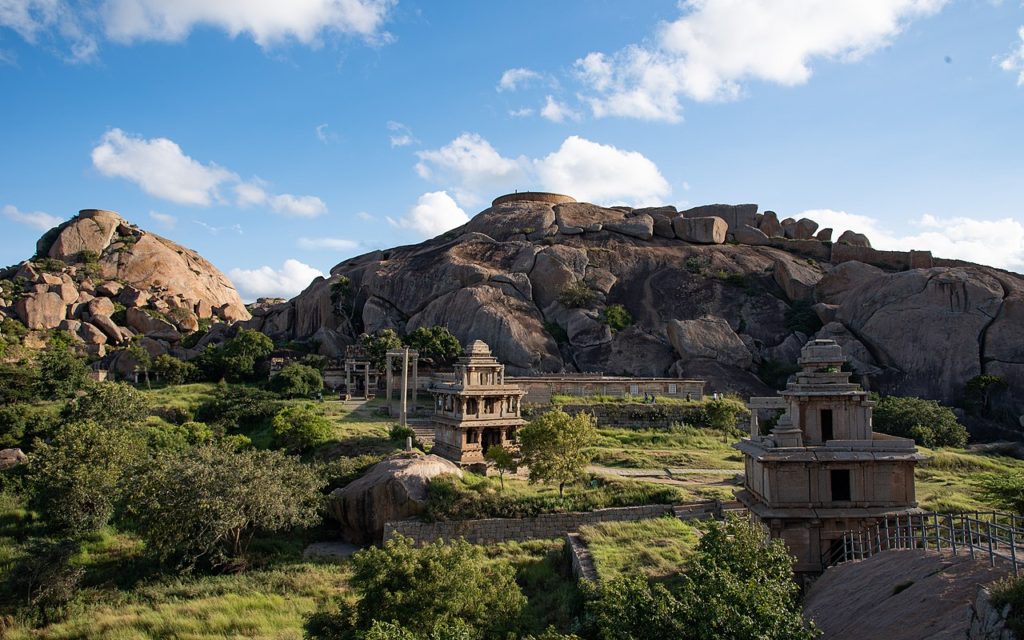
10. Madikeri Fort
Like some of the forts in India, Madikeri Fort too has seen change of hands over centuries. Built by Mudduraja in the 17th century, the fort has seen influence from Tipu Sultan, Lingarajendra Wodeyar II, Doddavira Rajendra and even the British extended the fort complex by adding a portico and a clock tower.
There is plenty to see inside the fort – St. Mark’s Church built by East India Company, Fort Museum, Madikeri palace, Kote Maha Ganapathi temple and Mahatma Gandhi Public Library.
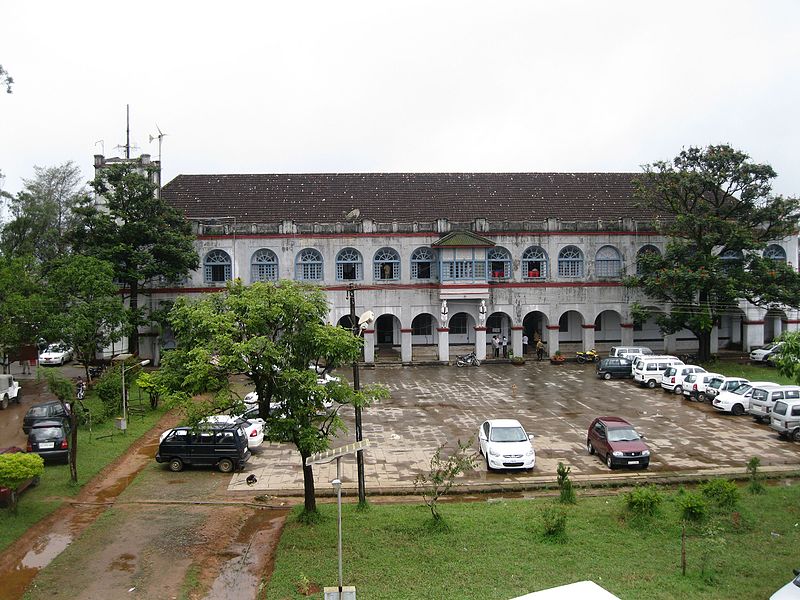
11. Mirjan Fort
The town of Mirjan is at a stone’s throw away distance from Gokarna. Mirjan was an important port town during the 16th century as it was used for shipping betel nut and pepper.
One of the most sophisticated forts of Karnataka, Mirjan Fort was built by Chennabhaira Devi of Gersoppa, one of the administrative districts of Uttara Kannada district. There are some discrepancies found in historical archives as some suggest that the fort was built by Sherif-ul Mulk, a noble from Bijapur, another version states that it was the Vijayanagara Empire that built the fort.
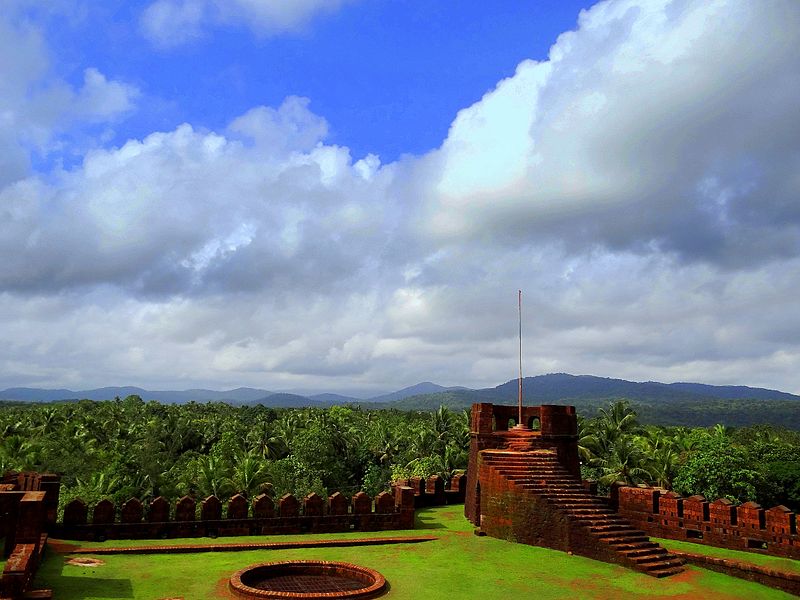
12. Srirangapatnam Fort
On the banks of kaveri lies Srirangapatnam Fort in South Indian state of Karnataka. The change of each reign meant additions and renovations to the fort which was initially a mud fort.
Srirangapatnam Fort is also known as Tipu’s Fort as it was here that Tipu had set his prime defence base. The elegance of Indo-Islamic influcnece with which the fort has been built can be seen even today. The most attractive feature of the fort is the Lal Mahal which was once the residence of the ruler of Mysore.
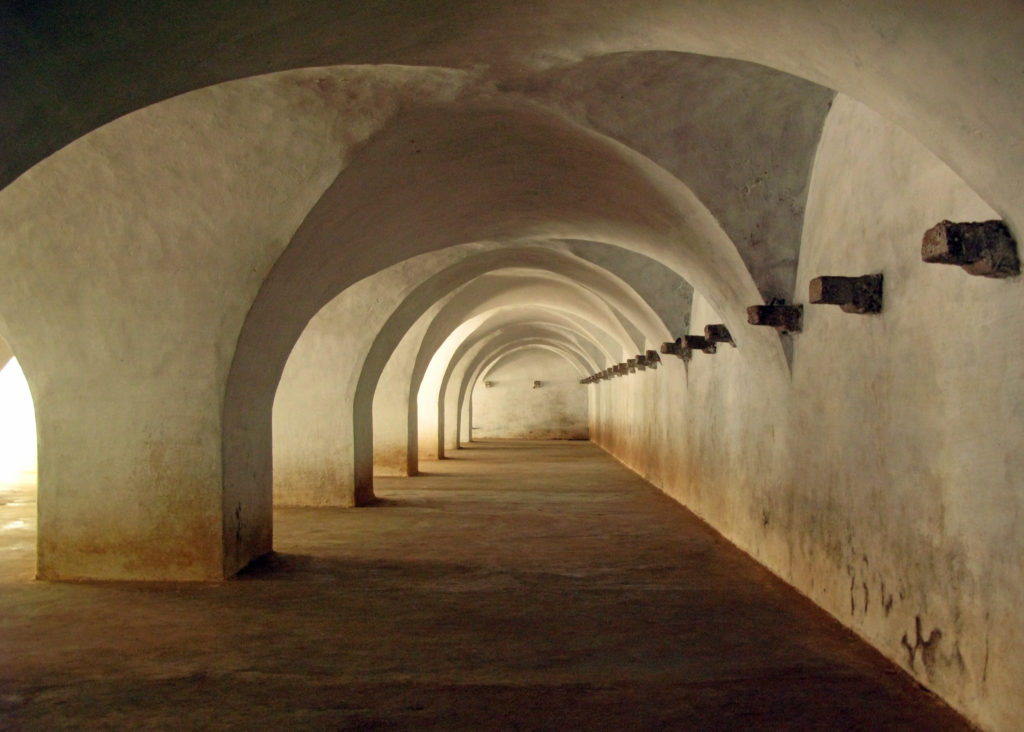
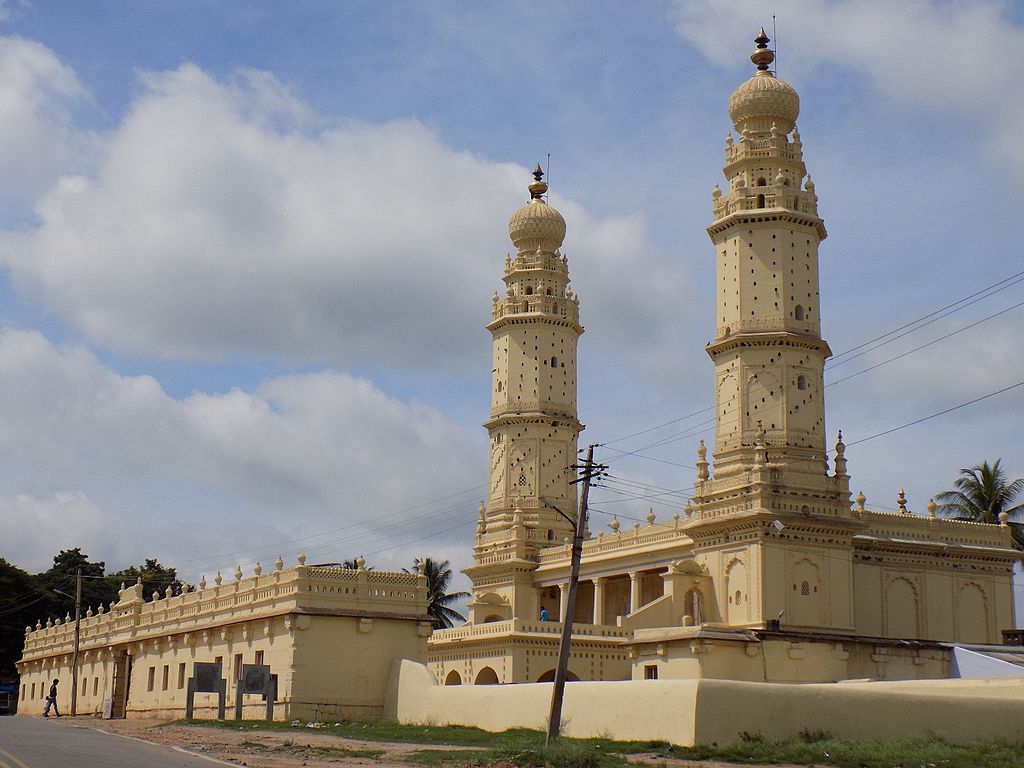
Forts in Kerala
13. Anchuthengu Fort
Around 10 kms from Varkala, lies the bustling town of Anchuthengu which was an old Portuguese settlement in the 16th century. The Anchuthengu Fort is one of the first stronghold of the East India Company on the Southwestern shoreline in India.
After getting a green signal from the Queen of Attingal – Umayamma Rani, the East India Company completed the construction of the fort in 1699. The Anchuthengu fort served as military base and the first signalling station for ships coming from England. The fort also ensured that the EIC broke the Dutch dominance from the Malabar coast.
The stunning views of the Arabian Sea makes Anchuthengu fort a perfect day trip destination. There is also a lighthouse on the fort premises which is open for visitors from 3 pm to 5 pm.
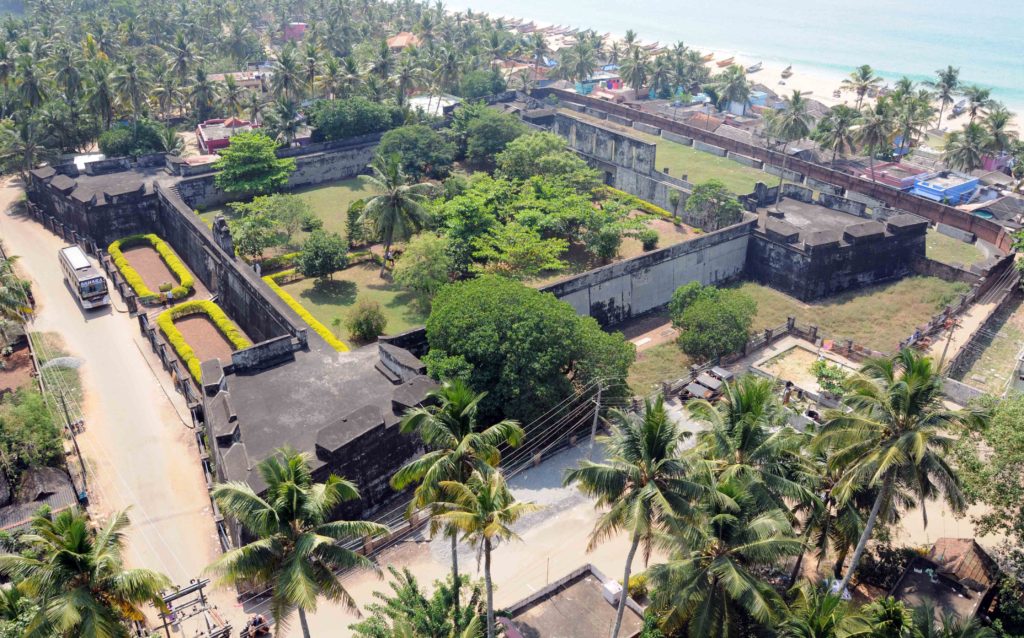
14. Bekal Fort
Recommended by : Kunjal Karaniya
A journalist by profession and a Roadtripper at heart! Kunjal is a travel nut, passionate photographer, travel blogger and not just a dreamer! Always up for exploring new places, in search of exciting experiences – Maps, DSLR and walking shoes are perfect match for her. Having explored 35 countries as yet, a new destination, unforgettable journey and an unusual experience, is always on her charts.
We were lucky to visit this beauty during monsoons while we were road-tripping south coast of India. This beauty of this fort lies in its sea-views and vast open landscapes. The largest and the best-preserved fort in Kerala ! It overlooks the beautiful Bekal beach.
It lies 16 Kms south of Kasaragod on the national highway at the northern tip of the state. The fort, a circular imposing structure rises 130 ft above sea level, stands on a 35 acre land that runs into the Arabian sea. This fort is more than 300 years old and is believed to have been built in the 1650’s by Sivappa Naik of the Ikkeri dynasty.
There is also an alternative belief that it was originally built by Kolathiri Rajas and later captured by Sivappa Naik. The fort was occupied by Hyder Ali of Mysore in 1763 A.D and then the Huzur of Canara during Tipu Sultan’s reign and later by the British. During the British rule, the former Bekal taluk was part of South Canara district and included the present Kasaragod and Hosdurg taluks.
The fort has no palaces inside and probably was built only for defence purporses. It has zigzag entrance, and strategically designed openings on the outer walls. The underground tunnels and the observation tower in the fort are remarkable. Just outside the fort there is a mosque built by Tipu Sultan of Mysore. At the entrance is the Anjaneya temple, dedicated to Sree Hanuman.




15. Palakkad Fort
Palakkad Fort is one of most well preserved forts in Kerala. Little is known about its origin but the fort was majorly under the influence of the Sultans of Mysore and the Britishers during the mid 18th century.
Maintained by ASI, the fort complex and the ground has been used by the locals to host sporting events and optical rallies. On the eastern entrance of the fort, there is temple dedicated to Lord Hanuman.
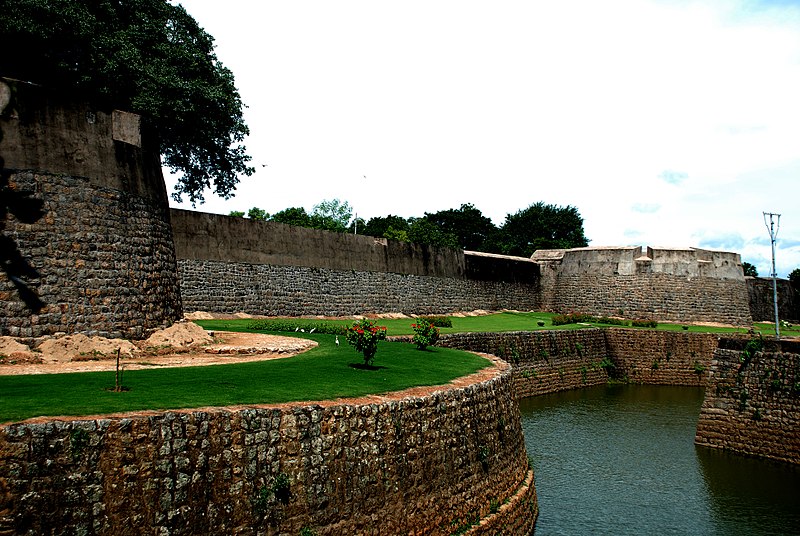
16. Pallipuram Fort
This fort is one of the three forts built by the Portuguese in India. The hexagonal structure of the fort is quite humble and made with laterite blocks, lime plaster and wood. The main entrance is adorned with a granite gateway. The ownership of the fort changed hands many times, in 1663 it was handed over to the Dutch. Almost 100 years later, the Raja of Travancore purchased the fort. And today, Kerala State Department of Archaeology is looking after the property.
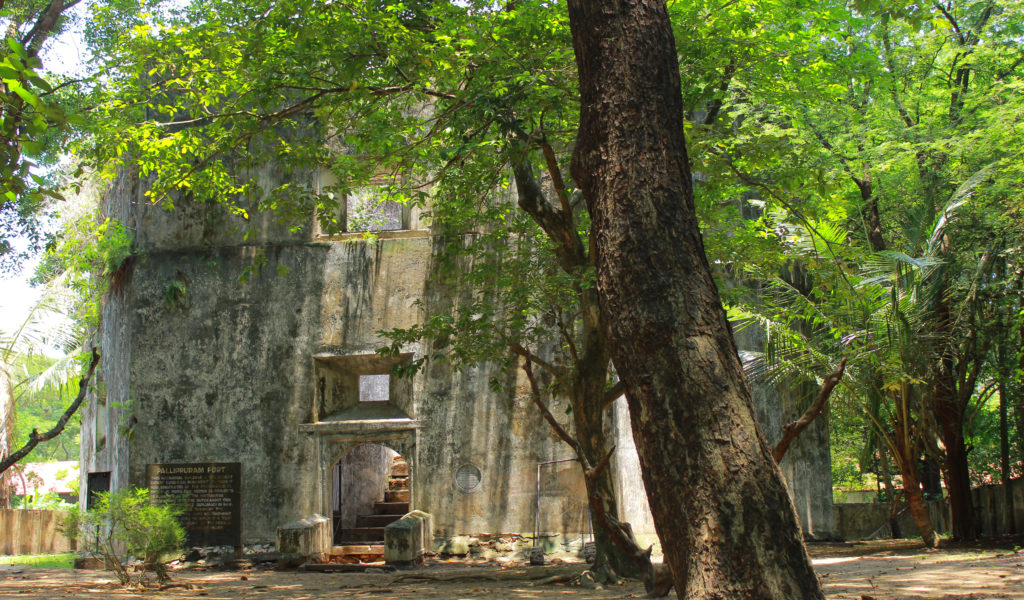
17. St. Angelo Fort
Recommended by : Aaron Ralston Coelho
Set in the largest city of North Malabar region of India – Kannur (Kerala) and deployed on the Mappilla bay of the Arabian sea stands this historical monument – St. Angelo Fort.
This triangular-shaped fort had its paradigm decked on 23rd October 1505 by the first Portuguese Viceroy, Francisco de Almeida. The history of this fort is as intriguing as it can get. It’s been in the hands of the Dutch, English and Indian rulers who’ve had roles in the metamorphosis of the fort which today serves as a famous and frequently visited tourist attraction in Kannur. This comprehensive beauty has evolved from earlier standing as a wooden outpost and garrison for Portuguese soldiers to a vast red laterite walled stronghold with multiple bastions bestowing a panoramic view of the Arabian sea.
One can visit this fortress anywhere between 8 AM – 6 PM and catch a sight of its huge chapels, prison, tombstones of the fallen soldiers, ammunition warehouses and its palatial architecture.
Well, there isn’t any entry fee in particular but there is a parking fee of Rs.20/-
Landing in God’s Own Country to gaze at this flawlessly harmonized piece of architecture will be so worth your while.
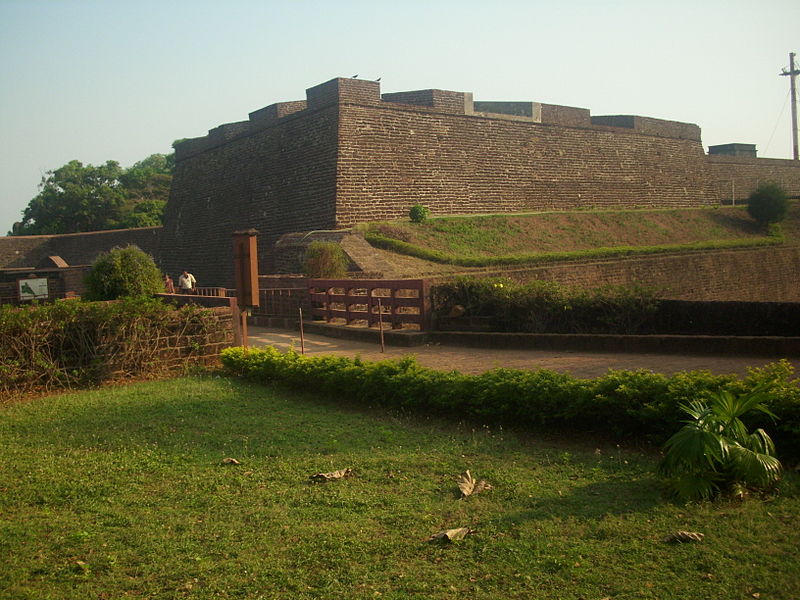
18. Thalassery Fort
Recommended by : Aaron Ralston Coelho
One of the most significant European trading centres during the colonial times of Kerala was the Thalassery Fort (also known as Tellicherry Fort). The fort unveils its grandeur resting on a rocky cliff of a low wooden hill running down to the sea. It is safeguarded by waters from the backside and instilled in the town of Thalassery of Kannur district facing the Arabian Sea.
In 1703 the East India Company established this enchanting edifice in a deliberate location to endure assaults and invasions as a testimony to the imperial rulers. The military activities and trade of exotic spices, hill products and timber from expansive woods played a prominent role in further fortification of the fort by the British during their reign over Thalassery.
Composed out of laterite blocks, elevated walls scaling upto 10 meters, strong bastions unfurling an aerial view and secret tunnels leading to the sea behind are few of the eye-catching elements of this edifice. This phenomenal square-shaped establishment also has a handsome and unmanned lighthouse inside and two underground chambers which were used to stock pepper and cardamom.
Thalassery Fort is orchestrated with elaborately carved doors. There stands an arch-shaped station at the entrance and a capacious courtyard ahead. The pride of Malabar is at 10 mins walking distance from the Thalassery Bus Stand.
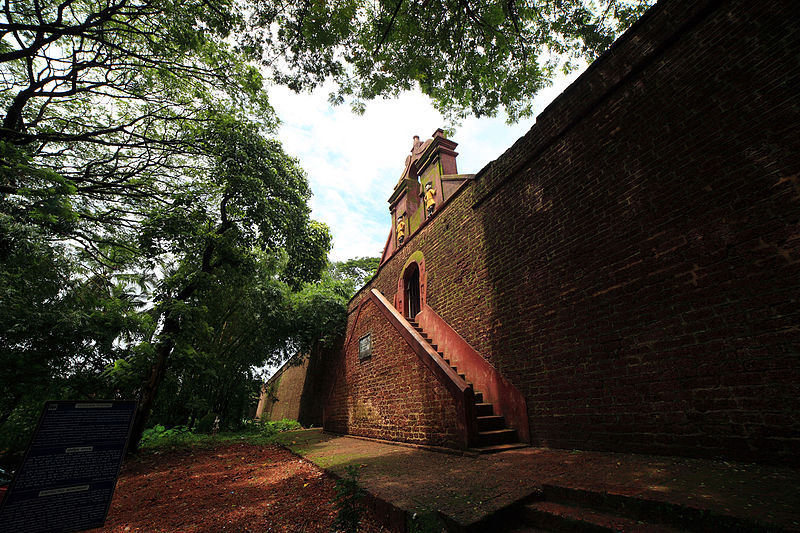
Forts in Tamil Nadu
19. Alamparai Fort
Recommended by : Aaron Ralston Coelho
The Alamparai Fort (also known as Alampara) is an archetype of robust structures that withstood the test of time and wreaking havoc of nature. Barely surviving on the edge of the Indian Ocean, this once-astonishing marvel was used by the French to mint coins, store weapons and artifacts. With a dockyard as long as 100mts, it also served as a port to export zari, salt and ghee. The Mughal rulers in charge of this 15-acre wide land passed it onto the French in 1750 post which it was ruthlessly ruined by the British army.
Fortunately, after enduring agony for over 350 years, the restoration of this brick and lime structure has been initiated by the Archaeology Department in January this year. The fort of Alampari will be brought back to life within 7 months to its fully remarkable beauty.
Situated on the East Coast Road, 100kms away from Chennai in this tiny village called Kadapakkam ( 50km away from Mamallapuram), its something to look forward to post the renewal.
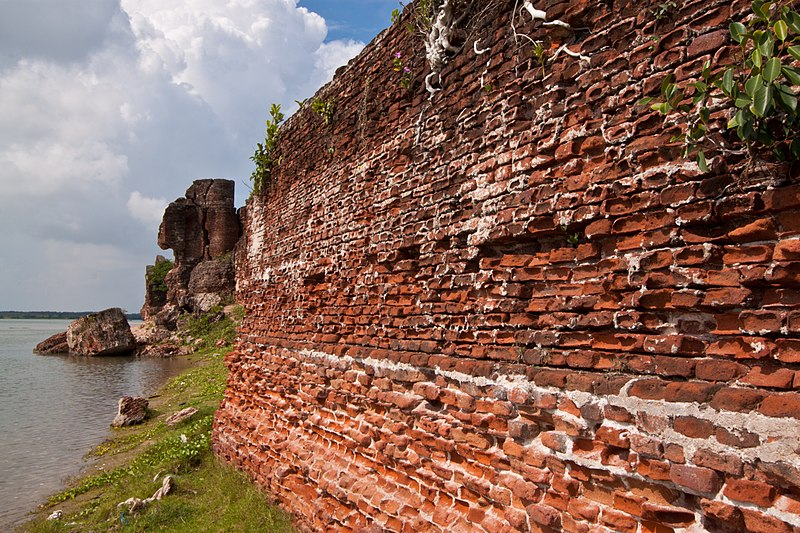
20. Fort Dansborg
Recommended by : Jayanti Pandey
A lover of books, an editor by profession, a translator in the Italian language, she divides her time between Dubai and Gurgaon. Her musings can be read on andsoifelt.wordpress.com.Home is where the heart is: and her heart could be in the Himalayas or equally in a remote cobbled street medieval hill town in Italy or even on the edge of the earth in the Arctic Lapland.
India was colonized by many a European nation. We all know about the British; but there were the French, The Portuguese and even the Danes.
Yes, the Danes came to India too and built Fort Dansborg in Tranquebar. Did you know this?
Tranquebar is a sleepy fishing village in Tamil Nadu on the shores of the Bay of Bengal. It is about 70kms driving distance from Pondicherry.
History of the Fort:
In the 17th century, Tranquebar acted as the base for the Danish settlement. Fort Dansborg was built on the land ceded by the Thanjavur king, Raghunatha Nayak, to the Danish Admiral, Ove Djedde, in 1620.
The Fort is the second largest Danish Fort after Kronburg.
It was sold to the British in 1845 and both the fort and the town of Tranquebar lost its importance as Tranquebar was not an active trading port for the British.
After Independence the Fort was used as an inspection bungalow till 1978. Then the Archaeological Department of Tamil Nadu took it over and now maintains it as a museum where artefacts of the Fort and the Danish Empire are displayed.
The Fort has been renovated twice, once in 2001 (with aid from the Danish royal family) and subsequently in 2011 (by the TN Tourism Department aided by Intach, Pondicherry).
Architectural details of the Fort:
Built in Danish style, the Fort is characterized by large halls, columned structures and high ceilings. Its length on the side facing the sea is 60m and its width, 11m. The Fort is trapezoidial in shape with three rooms in the left wing originally used as the governor’s residence. There is a kitchen with an open fireplace and a chimney. The church room, now a museum, is located in the centre of the building.
The original rectory and the rooms which are now used as store rooms comprise the right wing.
The second storey has a set of guard rooms.
The central part of the Fort has four camel hump shaped domes.
The Fort is built with bricks and its bastions use black stone.
Importance of the Fort:
The Fort acted as an important gateway in the trade route between Europe and the Coromandel Coast. A factory established soon after the Fort was constructed minted coins bearing the initials, TB or DB, indicating Dansborg. Protestant missionaries were sent by Denmark and two of them landed in 1706 in Tranquebar. They learnt Tamil and soon translated the New Testament into Tamil. This was printed in the printing press inside the Fort! The landing of the missionaries is marked by a cross in an open area to the left of the Fort.
Location:
Standing at the edge of the shore on the beach of Tranquebar, the Fort looks almost like a film set! It is worth a visit to know about Danish culture and its colonial history in India.
Trivia:
Tranquebar was the name of colonial times. The village is now called Tharangambadi which translates as ‘the land of the singing waves’. Isn’t that beautiful?
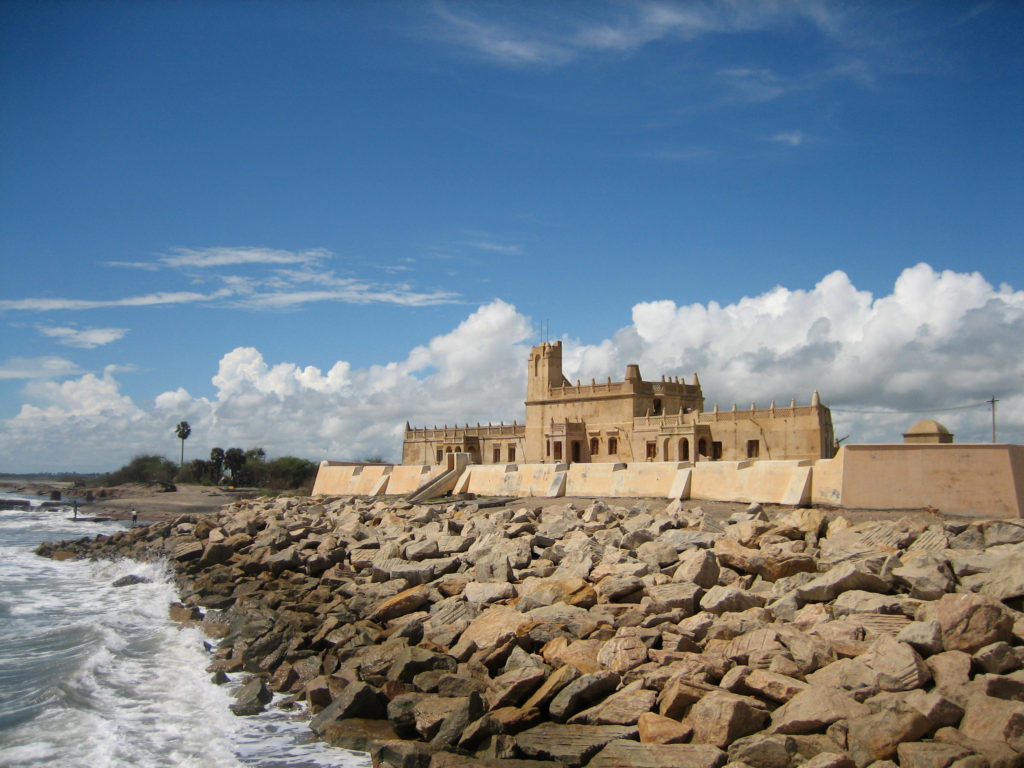
21. Gingee Fort
Recommended by : Aaron Ralston Coelho
One of the finest forts of Tamil Nadu, established in the 9th century in Villupuram district, based around 93 miles away from Chennai is the Gingee Fort (also known as Jinji or Senji)
This imperial fort has a massive circumference of thick walls and cliffs surrounding an area of 11 sq. km. that clasps three different hilltop citadels that served as an impregnable stronghold for the Cholas. The reputation of Gingee is quite immense for it is an unbreachable fort complex set on an ideal strategic location. This magnificent structure is stationed at a height of 800 feet with fort walls stretching out for 13km. The medieval European travellers have boasted about the glory of this fort by calling it the ‘Troy of the East’.
One can lay eyes on its famous seven-storeyed Kalyana Mahal, Aanaikulam (a sacred pond), prison cells, granaries and temples anywhere between 9:00 am-4:30 pm daily. The citadel offers a warm and pleasant hike to the top of the hill for the venturesome.

22. Thirumayam Fort
Recommended by : Aaron Ralston Coelho
This 40 acre wide disc-shaped fortress was constructed in 1687 with careful craftmanship by the late Raja of Ramnad, Vijaya Raghunatha Sethupathi and can be located on the Pudukkottai-Karaikudi Highway in the salient town of Thirumayam,Tamil Nadu.
Formerly, this circular fortified settlement was believed to have seven concentric walls, amongst which four currently stand strong. The combination of compact blocks of stone and bricks were utilized for the fabrication of the fort walls.
This larger-than-life fortress not only provides a 360 degree view of the empire but it also possesses alluring shrines with meticulously crafted sculptures. The rock cut temples perched on the southern slope hold much significance in the pages of history. Revamped by the Archaeological Survey of India in the year 2012, this blueprint of an iconic architecture is a must-visit.

23. Udaygiri Fort
Recommended by : Aaron Ralston Coelho
One can come across the tremendously renowned military asset of the Travancore dynasty, the Udayagiri Fort on the Thiruvananthapuram-Nagercoil National highway at Puliyoorkurichi, Tamil Nadu.
A resounding ancient structure initially formed as a mud-fort in the 17th century was later redefined with granite blocks into a 90-acre dominion in the 18th century by the Maharaja of Travancore, Marthanda Varma. The naval commander of the Dutch East India Company, Eustachius Benedictus de Lannoy was designated as the Chief of the Travancore army by the Maharaja. For 37 years, De Lannoy edified the Travancore soldiers with European techniques of fighting and thus giving it the name ‘Dillanai Kotta (De Lannoy’s Fort).
The Archaeological Department of India is currently safeguarding the antiquity of this domain that exhibits a natural park, herbal gardens, prison cells, secret tunnels, an aquarium and the fabricating unit of guns and ammunition. For a glimpse into the Travancore history one can visit De Lannoy’s tomb found in the ruins of the chapel.
This astounding fort can be visited anywhere between 8:00 am-7:00 pm at a fee of Rs.10 per person and Rs.10 for a camera in case you wish to capture some of its historic elegance.
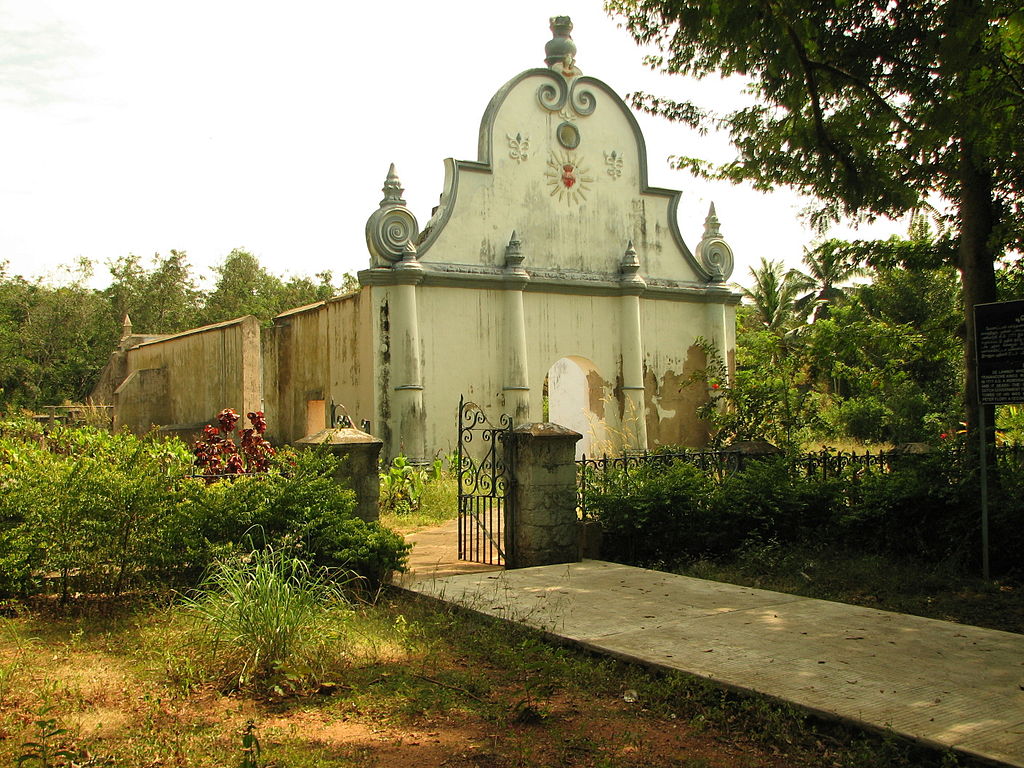
24. Vellore Fort
Recommended by : Aaron Ralston Coelho
Emerging from the 1566 AD, an unassailable and enormous fort located in the heart of the city of Vellore, Tamil Nadu, where the first ever mutiny led against the British transpired – Vellore Fort.
Chinna Bommi Reddy and Thimma Reddy Nayak laid the blueprint for this spectacular fort crafted from vast granite stones with its territory engulfing an area of 133 acres. A deep moat swarmed with 10,000 crocodiles was the first obstacle for invaders to prepare for before they could conquer the fort, which at the time had the finest military architecture in South India. Reigned by various sovereigns, the fort has changed hands exhibiting richness in its history from multiple Vijayanagara kings, to the Sultans of Bijapur, to the Marathas, to the Carnatic Nawabs and eventually to the British.
This sacred place is a melting pot of cultures where in the secularity of it is visible in the beauty of churches, mosques and temples erected in one compound. It also holds in its sweeping premises, the royal prison cells where rulers like Tipu Sultan and the last king of Srilanka were taken captives.
A must-visit is the Jalagandeeswarar Temple sculpted and crafted by some of the exceptional artisans of that era.

Forts in Telangana
25. Golconda Fort
Recommended by : Pawan Jindal
Majestic and imposing 16th century Golconda Fort is one of the most famous forts in India. Situated on a 120-m-high hill, and built on a hilltop by the Kakatiya dynasty , The Rajah of Warangal in the 13th century.It was originally a mud fort and fortified between 14th and 17th centuries by the Bahmani Sultans and then the ruling Qutub Shahi dynasty.
The inner fort contains ruins of palaces, mosques and a hill top pavilion, which rises about 130 meters high .From here , You can spot the stunning Deccan plateau and also get a bird’s eye view of the bustling twin cities of Hyderabad and Secunderabad .
Golconda fort’s former glory and majesty can still be seen in the mighty ramparts and fortifications encircling it.
The Golconda fort has cannons, four drawbridges, eight gateways, majestic halls, magazines and stables etc. The outermost enclosure is called Fateh Darwaza meaning Victory gate, after Aurangzeb’s army marched successfully through this gate in 1687 defeating Qutub Shahi dynasty.Aurangzeb looted and destroyed the fort and left it in a heap of ruins.
Golconda has many famous engineering marvels but the most spectacular, however, is the ingenious acoustics of the fort . If you clap your hand at a certain point near the dome entrance , it reverberates and heard clearly at the hill top pavilion , almost one kilometer away. This used to serve as a warning note to the inhabitants of the fort of any impending danger .
In the evening, a unique light and sound show brings the legend of Golconda to life. This show unfolds splendid saga of Golconda with a spectacular interplay of audio & visual effects. This fort is 11 kms from Hyderabad and you must visit it.
26. Medak Fort
Recommended by : Aaron Ralston Coelho
A majestic and robust citadel, shaped in the 12th century on the summit of a hill by the Kakatiya rulers is located in the northern part of Medak district, Telangana- Medak Fort.
It almost takes you a push to enter from the doorway of this captivating beauty because as soon as your gaze halts at the intricacy of the carefully sculpted doors, one tends to get lost into the whole other realm of kings and kingdoms of those days.
It takes just 500 steps to the top of the hill to catch sight of this graceful fortress. The first and the main entrance (Prathama Dwaram) spotlights the double-headed “Gandabherundam”, the emblem of the Vijayanagara Empire. The second entrance (Simha Dwaram) highlights two snarling lions, whose growls can almost be heard. The third one is the Elephant entrance (Gaja Dwaram) that features two intertwined elephants erected on either side of the entrance.
A 17th-century cannon (3.2m long) with a sanctified trident inscribed on it, a tranquil lake, a barrack, a warehouse, and the natural rocky barrier makes this an extraordinary fortress to visit once in a lifetime.
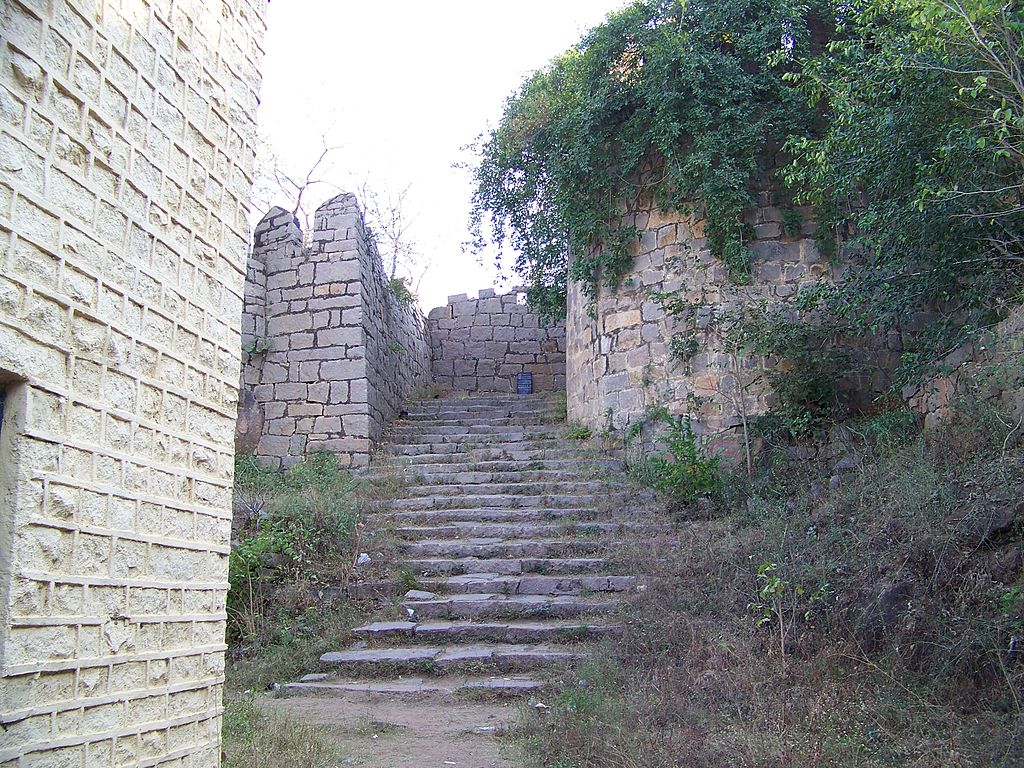
27. Ramagiri Fort
Recommended by : Aaron Ralston Coelho
Mounted on the summit of one of the Ramagiri hills, assembled from mud and stone is a 12th-century stronghold set up in the Peddapalli district of Telangana, the Ramagiri Fort (Ramagiri Khilla).
Established by the Kakatiyas of Warangal, the Ramagiri Fort is positioned in the midst of a thick forest cover, also home to a plethora of plant species that include many medicinal herbs. An exceptional view of river Manair merging into river Godavari, can be spotted when one ascends this magisterial fort. It has multiple octagonal-shaped bastions and four war cannons forged and soldered on a stone-made parapet, 12 meters from the ground.
The Ramagiri Khilla is open for visitors between 9:30 am – 6:30 pm on all days, via the Begumpet village situated 2 kms away. Given it’s scenic backdrop, this picturesque fort is bound to invigorate the trek-lover in you.
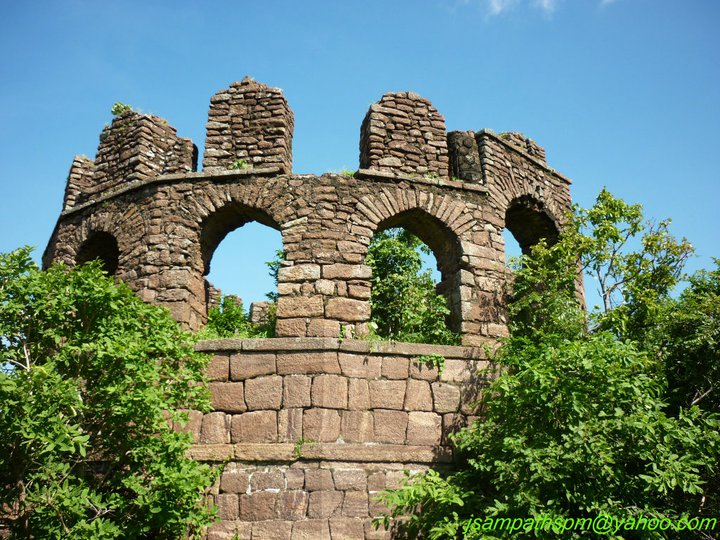
28. Wranagal Fort
Recommended by: Aaron Ralston Coelho
Shaped in the 12th-century, set up in Warangal district, Telangana, which was earlier the capital city of the Kakatiya dynasty stands this sumptuous fortress- Warangal Fort. Unfurling over a radius of 19 kilometers between Warangal and Hanamkonda, this grandeur is enumerated in the list of UNESCO World Heritage Sites.
This stronghold has suppressed multiple sieges from invaders largely due to its strategic fortifications. It had three circular walls around the fort in concentric patterns forming its first line of defense. Each wall was further aided with moats made from stone and granite to protect the capital. The keep was surrounded by forty-five towers with large rectangular bastions rising up to a height of 60 feet.
This architectural wonder has four different entrances with pillared gates 10 meters in height leading to a Shiva temple that lies in ruins now. The gripping architecture, ecstatic carvings, and exclusive sculptures are elements of this majestic fortress that is sure to leave you astonished.
Pro-tip:
Rs.15 per person for Indians
Rs.200 per person for Foreign Tourists
Rs.25 for Video Camera
